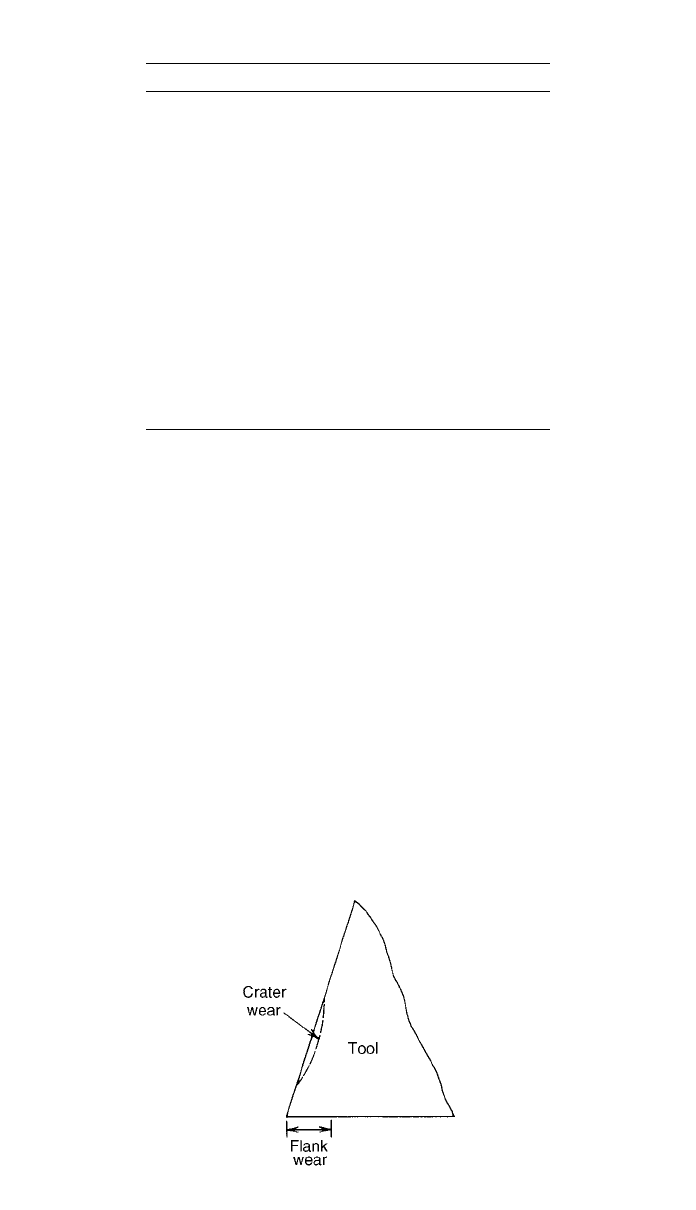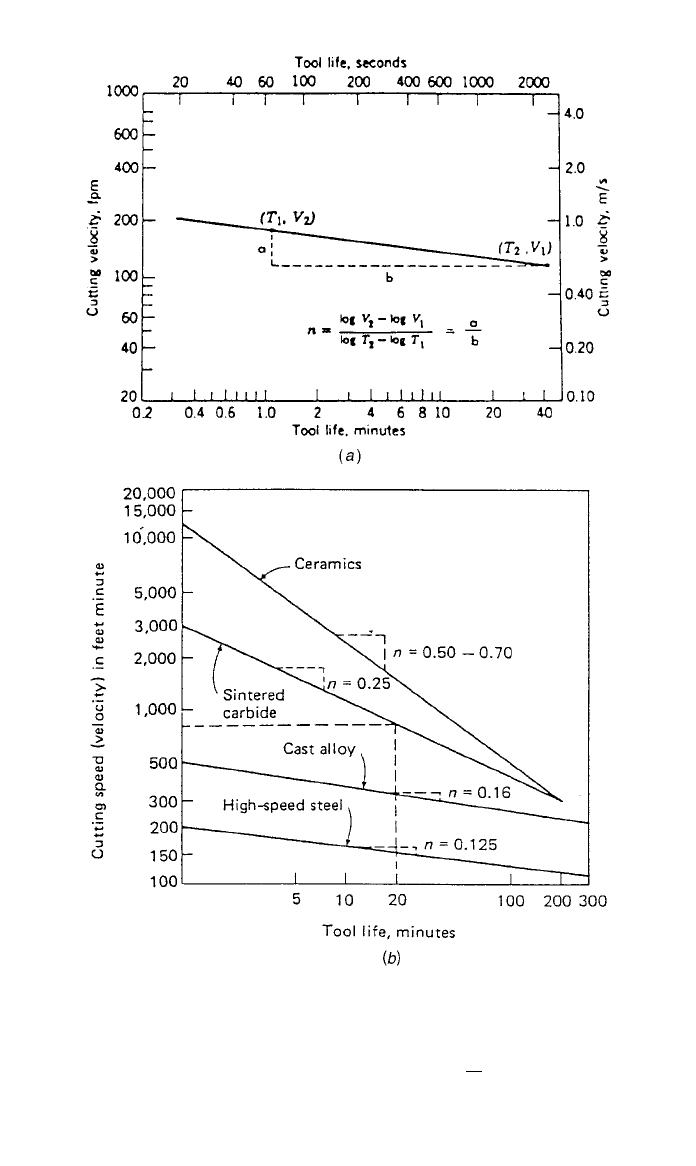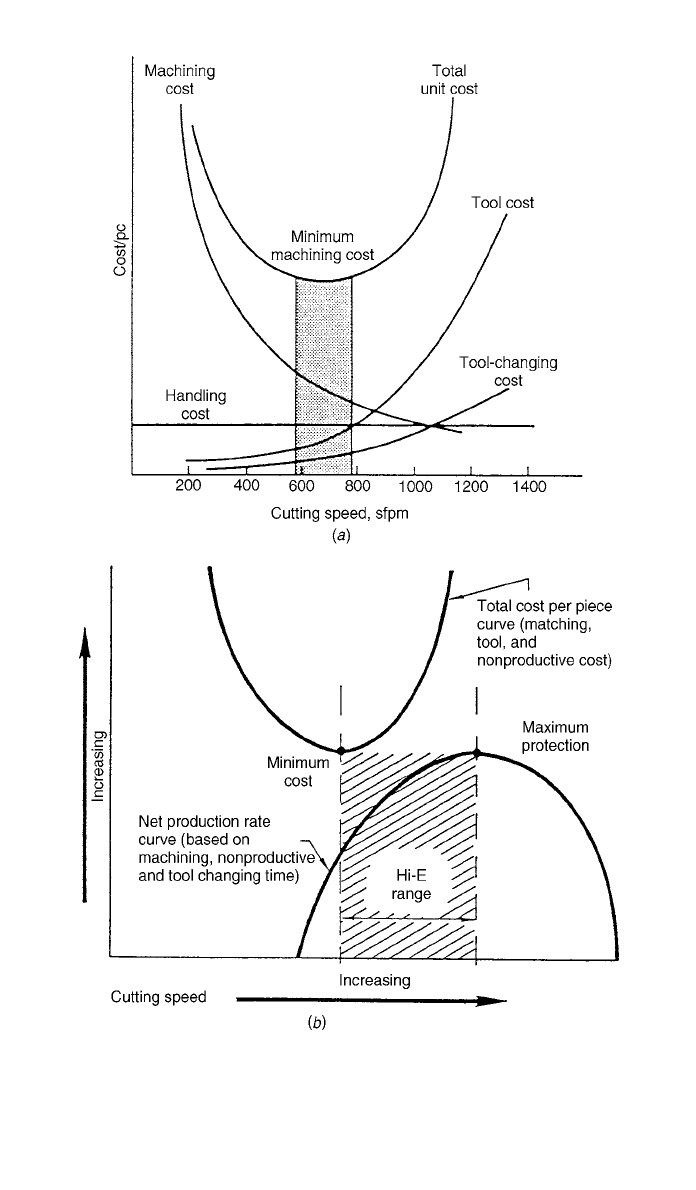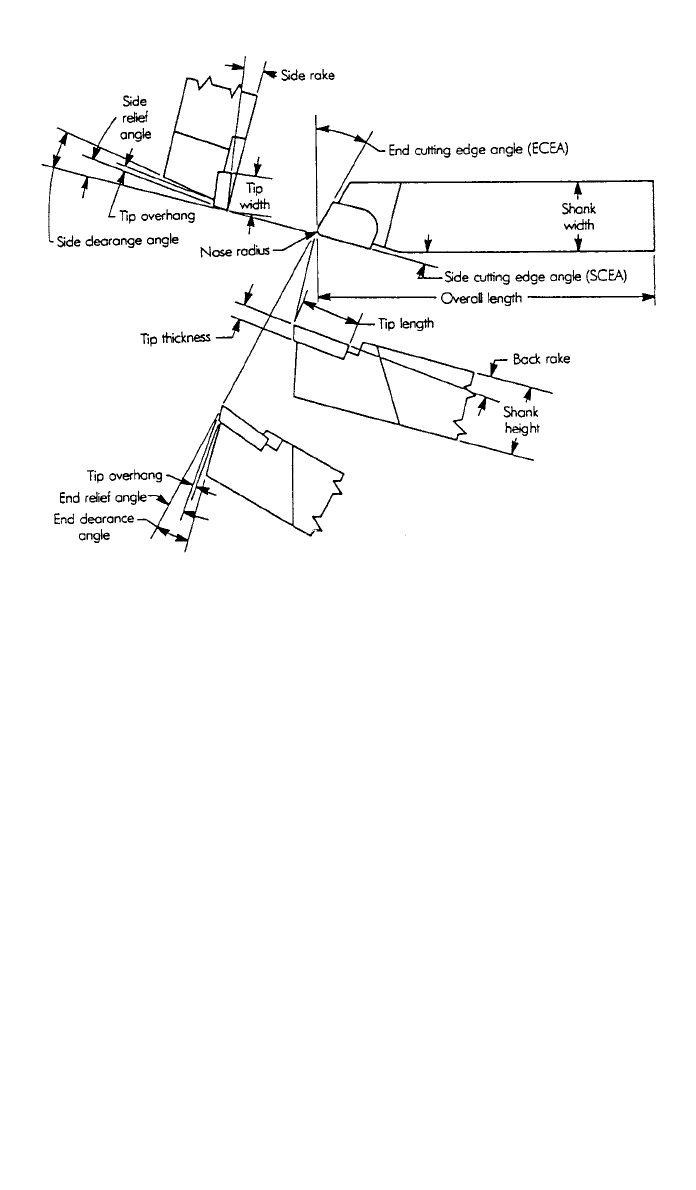Kutz M. Handbook of materials selection
Подождите немного. Документ загружается.


2 MACHINING POWER AND CUTTING FORCES 853
Table 1 Average Values of Energy per Unit Material Removal Rate
Material Bhn HP
c
/in.
3
per min W / mm
3
per sec
Aluminum alloys 50–100 0.3 0.8
100–150 0.4 1.1
Cast iron 125–190 0.5 1.6
190–250 1.6 4.4
Carbon steels 150–200 1.1 3.0
200–250 1.4 3.8
250–350 1.6 4.4
Leaded steels 150–175 0.7 1.9
Alloy steels 180–250 1.6 4.4
250–400 2.4 6.6
Stainless steels 135–275 1.5 4.1
Copper 125–140 1.0 2.7
Copper alloys 100–150 0.8 2.2
Leaded brass 60 –120 0.7 1.9
Unleaded brass 50 1.0 2.7
Magnesium alloys 40–70 0.2 0.55
70–160 0.4 1.1
Nickel alloys 100–350 2.0 5.5
Refractory alloys
(Tantalum, Columbium,
Molybdenum)
210–230 2.0 5.5
Tungsten 320 3.0 8.0
Titanium alloys 250–375 1.3 3.5
The specific energies for different materials, using sharp tools, are given in
Table 1.
power
⫽ FV⫽ F 2
RN
cc
⫽ FR2
N
c
⫽ M2
N (10)
MN
⫽ HP (11)
63,025
where M
⫽ torque, in.–lbf
N
⫽ revolutions per min
In SI units,
MN
⫽ KW (12)
9549
where M
⫽ newton–meter
HP/cu in./min 2.73
⫽ ? W/(cu mm/sec)
M
⫽ F
c
R ⫽ power/2
N
F
c
⫽ M/R

854 PRODUCTION PROCESSES AND EQUIPMENT FOR METALS
Table 2 Feed Correction (C)
Factors for Turning, Milling, Drilling,
Planing, and Shaping
Feed
(ipr or ips)
mm/rev
or mm / stroke Factor
0.002 0.05 1.4
0.005 0.12 1.2
0.008 0.20 1.05
0.012 0.30 1.0
0.020 0.50 0.9
0.030 0.75 0.80
0.040 1.00 0.80
0.050 1.25 0.75
gross power ⫽ cutting power/e (13)
m
The cutting horsepowers for different machining operations are given below.
For turning, planing, and shaping,
HP
⫽ (HP )12CWVƒd (14)
c
For milling,
HP
⫽ (HP )CWFwd (15)
c
For drilling,
2
D
HP ⫽ (HP )CW(N)ƒ (16)
冉冊
c
4
For broaching,
HP
⫽ (HP )12CWVn wd (17)
c
ct
where V ⫽ cutting speed, fpm
C
⫽ feed correction factor
ƒ
⫽ feed, ipr (turning and drilling), ips (planing and shaping)
F
⫽ feed, ipm ⫽ ƒ ⫻ N
d
⫽ depth of cut, in.
d
t
⫽ maximum depth of cut per tooth, in.
n
c
⫽ number of teeth engaged in work
w
⫽ width of cut, in.
W
⫽ tool wear factor
Specific energy is affected by changes in feed rate. Table 2 gives feed correction
factor (C). Cutting speed and depth of cut have no significant effect on power.
Tool wear effect factor (W) is given in Table 3.

3 TOOL LIFE 855
Table 3 Tool Wear Factors (W)
Type of Operations
a
W
Turning
Finish turning (light cuts) 1.10
Normal rough and semifinish turning 1.30
Extra-heavy-duty rough turning 1.60–2.00
Milling
Slab milling 1.10
End milling 1.10
Light and medium face milling 1.10–1.25
Extra-heavy-duty face milling 1.30–1.60
Drilling
Normal drilling 1.30
Drilling hard-to-machine materials and
drilling with a very dull drill
1.50
Broaching
Normal broaching 1.05 –1.10
Heavy-duty surface broaching 1.20–1.30
a
For all operations with sharp cutting tools.
Fig. 5 Types of tool wear.
The gross power is calculated by applying the overall efficiency factor (e
m
).
3 TOOL LIFE
Tool life is a measure of the length of time a tool will cut satisfactorily, and
may be measured in different ways. Tool wear, as in Fig. 5, is a measure of tool
failure if it reaches a certain limit. These limits are usually 0.062 in. (1.58 mm)
for high-speed tools and 0.030 in. (0.76 mm) for carbide tools. In some cases,
the life is determined by surface finish deterioration and an increase in cutting
forces. The cutting speed is the variable that has the greatest effect on tool life.
The relationship between tool life and cutting speed is given by the Taylor
equation.
n
VT ⫽ C (18)

856 PRODUCTION PROCESSES AND EQUIPMENT FOR METALS
Table 4 Average Values of n
Tool Material Work Material n
HSS (18-4-1) Steel 0.15
C.I. 0.25
Light metals 0.40
Cemented carbide Steel 0.30
C.I. 0.25
Sintered carbide Steel 0.50
Ceramics Steel 0.70
where V ⫽ cutting speed, fpm (m/sec)
T
⫽ tool life, min (sec)
n
⫽ exponent depending on cutting condition
C
⫽ constant, the cutting speed for a tool life of 1 min
Table 4 gives the approximate ranges for the exponent n. Taylor’s equation
is equivalent to
log V
⫽ C ⫺ n log T (19)
which when plotted on log–log paper gives a straight line, as shown in Fig. 6.
Equation (20) incorporates the size of cut:
nn1 n2
K ⫽ VT ƒ d (20)
Average values for n
1
⫽ .5–.8
n
2
⫽ .2–.4
Equation (21) incorporates the hardness of the workpiece:
nn1 n2 1.25
K ⫽ VT ƒ d (BHN) (21)
4 METAL-CUTTING ECONOMICS
The efficiency of machine tools increases as cutting speeds increase, but tool
life is reduced. The main objective of metal-cutting economics is to achieve the
optimum conditions, that is, the minimum cost while considering the principal
individual costs: machining cost, tool cost, tool-changing cost, and handling cost.
Figure 7 shows the relationships among these four factors.
machining cost
⫽ Ct (22)
om
where C
o
⫽ operating cost per minute, which is equal to the machine operator’s
rate plus appropriate overhead
t
m
⫽ machine time in minutes, which is equal to L/(ƒN), where L is the
axial length of cut

4 METAL-CUTTING ECONOMICS 857
Fig. 6 Cutting speed/ tool life relationship.
t
m
tool cost per operation ⫽ C (23)
t
T
where C
t
⫽ tool cost per cutting edge
T
⫽ tool life, which is equal to (C/V)
1/n

858 PRODUCTION PROCESSES AND EQUIPMENT FOR METALS
Fig. 7 Cost factors.

5 CUTTING-TOOL MATERIALS 859
tool changing cost ⫽ Ct(t /T) (24)
oc m
where t
c
⫽ tool changing time, min
handling cost
⫽ Ct
oh
where t
h
⫽ handling time, min
The average unit cost C
u
will be equal to
t
m
C ⫽ Ct ⫹ (C ⫹ Ct) ⫹ Ct (25)
u om t oc oh
T
4.1 Cutting Speed for Minimum Cost (V
min
)
Differentiating the costs with respect to cutting speed and setting the results
equal to zero will result in V
min
:
C
V ⫽ (26)
min
n
Ct⫹ C
1
ot
⫺ 1
冉冊冉 冊
nC
o
4.2 Tool Life Minimum Cost (T
min
)
Since the constant C is the same in Taylor’s equation and Eq. (23), and if V
corresponds to V
min
, then the tool life that corresponds to the cutting speed for
minimum cost is
Ct
⫹ C
1
oc t
T ⫽⫺1 (27)
冉冊冉 冊
min
nC
o
4.3 Cutting Speed for Maximum Production (V
max
)
This speed can be determined from Eq. (26) for the cutting speed for minimum
cost by assuming that the tool cost is negligible, that is, by setting C
1
⫽ 0:
C
V ⫽ (28)
max
n
1
⫺ 1 t
冋冉 冊 册
c
n
4.4 Tool Life for Maximum Production (T
max
)
By analogy to Taylor’s equation, the tool life that corresponds to the maximum
production rate is given by
1
T ⫽⫺1 t (29)
冉冊
max c
n
5 CUTTING-TOOL MATERIALS
The desirable properties for any tool material include the ability to resist soft-
ening at high temperature, which is known as red hardness; a low coefficient of

860 PRODUCTION PROCESSES AND EQUIPMENT FOR METALS
friction; wear resistance; sufficient toughness and shock resistance to avoid frac-
ture; and inertness with respect to workpiece material.
The principal materials used for cutting tools are carbon steels, cast nonfer-
rous alloys, carbides, ceramic tools or oxides, and diamonds.
1. High-carbon steels contain (0.8–1.2%) carbon. These steels have good
hardening ability, and with proper heat treatment hold a sharp cutting
edge where excessive abrasion and high heat are absent. Because these
tools lose hardness at around 600
⬚F (315⬚C), they are not suitable for
high speeds and heavy-duty work.
2. High-speed steels (HSS) are high in alloy contents such as tungsten,
chromium, vanadium, molybdenum, and cobalt. High-speed steels have
excellent hardenability and will retain a keen cutting edge to temperatures
around 1200
⬚F (650 ⬚C).
3. Cast nonferrous alloys contain principally chromium, cobalt, and tung-
sten, with smaller percentages of one or more carbide-forming elements,
such as tantalum, molybdenum, or boron. Cast-alloy tools can maintain
good cutting edges at temperatures up to 1700
⬚F (935⬚C) and can be used
at twice the cutting speed as HSS and still maintain the same feed. Cast
alloys are not as tough as HSS and have less shock resistance.
4. Carbides are made by powder-metallurgy techniques. The metal powders
used are tungsten carbide (WC), cobalt (Co), titanium carbide (TiC), and
tantalum carbide (TaC) in different ratios. Carbide will maintain a keen
cutting edge at temperatures over 2200
⬚F (1210⬚C) and can be used at
speeds two or three times those of cast alloy tools.
5. Coated tools, cutting tools, and inserts are coated by titanium nitride
(TiN), titanium carbide (TiC), titanium carbonitride (TiCN), aluminum
oxide (Al
2
O
3
), and diamond. Cutting speeds can be increased by 50%
due to coating.
6. Ceramic or oxide tool inserts are made from aluminum oxide (Al
2
O
3
)
grains with minor additions of titanium, magnesium, or chromium oxide
by powder-metallurgy techniques. These inserts have an extremely high
abrasion resistance and compressive strength, lack affinity for metals be-
ing cut, resistance to cratering and heat conductivity. They are harder
than cemented carbides but lack impact toughness. The ceramic tool soft-
ening point is above 2000
⬚F (1090⬚C) and these tools can be used at high
speeds (1500–2000 ft/min) with large depth of cut. Ceramic tools have
tremendous potential because they are composed of materials that are
abundant in the earth’s crust. Optimum cutting conditions can be achieved
by applying negative rank angles (5–7
⬚), rigid tool mountings, and rigid
machine tools.
7. Cubic boron nitride (CBN) is the hardest material presently available,
next to diamond. CBN is suitable for machining hardened ferrous and
high-temperature alloys. Metal removal rates up to 20 times those of
carbide cutting tools were achieved.
8. Single-crystal diamonds are used for light cuts at high speeds of
1000–5000 fpm to achieve good surface finish and dimensional accuracy.

5 CUTTING-TOOL MATERIALS 861
They are used also for hard materials difficult to cut with other tool
material.
9. Polycrystalline diamond cutting tools consist of fine diamond crystals,
natural or synthetic, that are bonded together under high pressure and
temperature. They are suitable for machining nonferrous metals and non-
metallic materials.
5.1 Cutting-Tool Geometry
The shape and position of the tool relative to the workpiece have a very impor-
tant effect in metal cutting. There are six single-point tool angles critical to the
machining process. These can be divided into three groups.
Rake angles affect the direction of chip flow, the characteristics of chip for-
mation, and tool life. Positive rake angles reduce the cutting forces and direct
the chip flow away from the material. Negative rake angles increase cutting
forces but provide greater strength, as is recommended for hard materials.
Relief angles avoid excessive friction between the tool and workpiece and
allow better access of coolant to tool–work interface.
The side cutting-edge angle allows the full load of the cut to be built up
gradually. The end cutting-edge angle allows sufficient clearance so that the
surface of the tool behind the cutting point will not rub over the work surface.
The purpose of the nose radiuses is to give a smooth surface finish and to
increase the tool life by increasing the strength of the cutting edge. The elements
of the single-point tool are written in the following order: back rake angle, side
rake angle, end relief angle, side relief angle, end cutting-edge angle, side cut-
ting-edge angle, and nose radius. Figure 8 shows the basic tool geometry.
Cutting tools used in various machining operations often appear to be very
different from the single-point tool in Figure 8. Often they have several cutting
edges, as in the case of drills, broaches, saws, and milling cutters. Simple anal-
ysis will show that such tools are comprised of a number of single-point cutting
edges arranged so as to cut simultaneously or sequentially.
5.2 Cutting Fluids
The major roles of the cutting fluids—liquids or gases—are
1. Removal of the heat friction and deformation
2. Reduction of friction among chip, tool, and workpiece
3. Washing away chips
4. Reduction of possible corrosion on both workpiece and machine
5. Prevention of built-up edges
Cutting fluids work as coolants and lubricants. Cutting fluids applied depend
primarily on the kind of material being used and the type of operation. The four
major types of cutting fluids are
1. Soluble oil emulsions with water-to-oil ratios of 20:1 to 80:1
2. Oils
3. Chemicals and synthetics
4. Air

862 PRODUCTION PROCESSES AND EQUIPMENT FOR METALS
Fig. 8 Basic tool geometry.
At low cutting speeds (40 ft/min and below), oils are highly recommended,
especially in tapping, reaming, and gear and thread machining. Cutting fluids
with the maximum specific heat, such as soluble oil emulsions, are recommended
at high speeds.
5.3 Machinability
Machinability refers to a system for rating materials on the basis of their relative
ability to be machined easily, long tool life, low cutting forces, and acceptable
surface finish. Additives such as lead, manganese sulfide, or sodium sulfide with
percentages less than 3% can improve the machinability of steel and copper-
based alloys, such as brass and bronze. In aluminum alloys, additions up to
1–3% of zinc and magnesium improve their machinability.
5.4 Cutting Speeds and Feeds
Cutting speed is expressed in feet per minute (m/sec) and is the relative surface
speed between the cutting tool and the workpiece. It may be expressed by the
simple formula CS
⫽
DN/12 fpm in., where D is the diameter of the workpiece
in inches in case of turning or the diameter of the cutting tool in case of drilling,
reaming, boring, and milling, and N is the revolutions per minute. If D is given
in millimeters, the cutting speed is CS
⫽
DN/60,000 m/sec.
Feed refers to the rate at which a cutting tool advances along or into the
surface of the workpiece. For machines in which either the workpiece or the
tool turns, feed is expressed in inches per revolution (ipr) (mm/rev). For recip-
